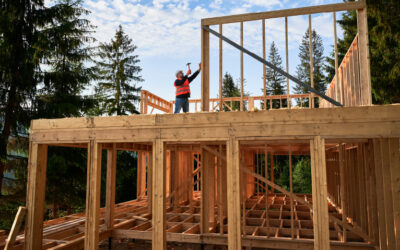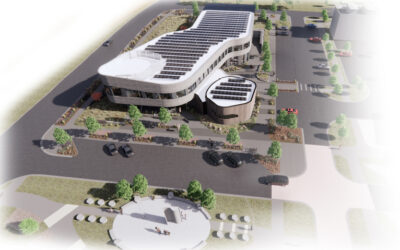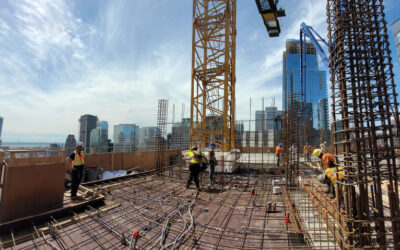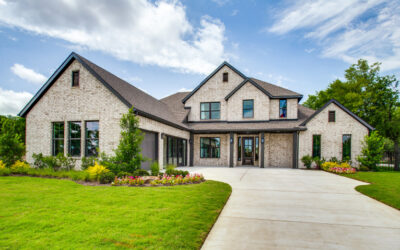True story: two female real estate developers turned the site of a former strip club in Toronto into a nine-story, 197-unit condo building named Reina, which is the Spanish word for queen. In a first for the city, they assembled an all-woman team of architects, engineers, planners, construction managers and lawyers to get the job done.
Yes, they were on a mission to show that women can deliver the goods just as well as men in what’s long been a male-dominated industry. At the same time, they’re also bringing different perspectives to design and construction.
While roughly 67 percent of certified realtors are female, women represent only 35 percent of the workforce in the lucrative commercial real estate field and hold just 11 percent of C-suite positions. Oprah Magazine reported these statistics in a feature on women trailblazers that included Reina’s Sherry Larjani and Taya Cook.
“After 15 years in the industry, I’ve become accustomed to being the only woman in meetings,” Cook said.
The final project plan, unveiled last summer, is the result of a full year of consultation and collaboration with colleagues, potential buyers and community members of all ages. The team even held a workshop with the Girl Guides to talk about their dream teen spaces, and launched a design competition for local college and university students to create smart, compact kitchens and bathrooms, storage ideas and other amenities for condo living.
“One thing we heard is that most condos are designed for the young and chic and look like modern hotels, so we had to consider how design can be extended to include families with young children or seniors,” Cook said. People wanted a place that was warm and inviting with a sense of community.
The building’s modern offerings include a yoga studio with a view to the kids’ playroom, stroller parking and a snack shack for all ages. Outdoors, the multi-use courtyard will boast barbecues, dining harvest tables, shared outdoor workstations and a children’s play area.
Cook and Larjani also saw that parents and their kids were walking through the Reina site to get to nearby schools. So they moved the building site back and added a walkway for safe passage for kids heading to and from school. Giving back to the neighbourhood is part of their mandate.
Most, if not all, cities are designed by men, so what could change if women had greater influence on city planning? Consider the need for more spacious public bathrooms that also allow room to maneuver strollers in and out. How about more seating and tables by kids’ playgrounds, and more pedestrian-only spaces for simply hanging out with the family?
These are some of the changes you’d see, according to Punt 6, a feminist collective of urban planners in Barcelona. The group has been “obsessing about this for over a decade,” looking at numerous ways cities can work better for women, the BBC reported.
The female perspective can bring improvements that start with identifying women’s needs. Physiology, for example, means that women need to use the bathroom more often than men, and women spend three times as long in bathrooms. As women are the predominant caregivers of young kids, they need places in public to sit down, give their kids snacks and rest while they watch their kids play.
And there’s a lot to be gained in a city’s function, appeal and sustainability, said Punt 6 members.
The group has done a lot of research into the different journeys of men and women and how they play out in city spaces. In terms of movement and transportation in Barcelona, the city’s design is very male-centric. Women travel by foot and use public transit more than men, while men travel more by car. That said, about 60 percent of public space is taken up by cars for travel and parking. More needs to be done to rebalance the space so everyone has access. Strategy should start with inclusivity.
To this end, Barcelona has some interesting projects in the works. One is called a “superblock” to reclaim the streets for cyclists, pedestrians or just for relaxing and socializing. The plan takes nine city blocks to form one big block which is closed off from through traffic, with underground parking. So instead of hectic intersections, there are parks, more green spaces and trees, picnic benches and play areas. These rest spots are also helpful for people with mobility issues like older seniors. Barcelona has built six of these and the plan is to extend superblocks to more than 500.
Another initiative is kiosks that provide a contact point and information to help protect women from risk. The city has launched an app where people can report any sexual aggression they’ve seen or experienced, with the aim to create a map of where these incidents are happening so the city can stop them.
In Paris, Mayor Anne Hidalgo has established more pedestrian and bike-friendly spaces. She’s also promoting the concept of the “15-minute city,” where people’s homes, places of work, education, health care, shopping and entertainment are all within a 15-minute walk or bike ride. When cities are re-shaping or planning housing developments, this kind of connectedness helps people balance work and family commitments. Families and friends can build in more time to spend together.
And in Vienna, the neighbourhood of Aspern is one of the largest urban developments in Europe, slated for completion in 2028. It will be home to 20,000 people and another 20,000 workplaces, with an explicitly family-oriented design. There are wide sidewalks and an artificial lake, and half the area is devoted to public space.
Aspern is billed as a model city-within-a-city, in a place that already has a highly rated quality of life. By the way, all the streets and public spaces in Aspern are named for women.
Closer to home, in New York, a female former transport commissioner for the city is the architect behind cutting congestion and creating new multi-use outdoor spaces. Janette Sadik-Kahn has helped create 400 miles of bike paths and more than 60 plazas to open up the densely populated city, the Financial Times reported.
Here’s the thing: according to the World Bank, women hold only 10 percent of senior jobs at leading architecture firms around the globe. So it’s understandable why urban planning is dominated by men, and why cities tend to work better for men than they do for women. “Men, women, gender minorities, and people of different abilities tend to use the public space in different ways,” said Sameh Wahba, a World Bank director.
“However, if the city is built for the ‘neutral’ male user, it neglects the needs, interests and routines” of others. This impacts women’s access to jobs or schools, and ultimately, their freedoms and safety.
The World Bank recently developed a guidebook for practitioners and city planners that sets out practical approaches, activities and guidelines for inclusive design. The guidelines are adaptable for housing, public transport, other infrastructure and city master plans.
“The argument is, you get a fairer society,” Eva Kail of Vienna’s strategic planning unit told The Guardian. “As a public administration, to offer good service for the people – to have better quality of life – you have to take care of gender equality.”













